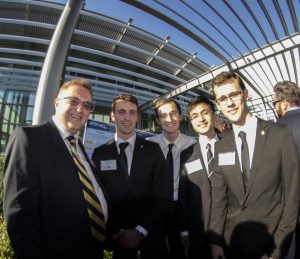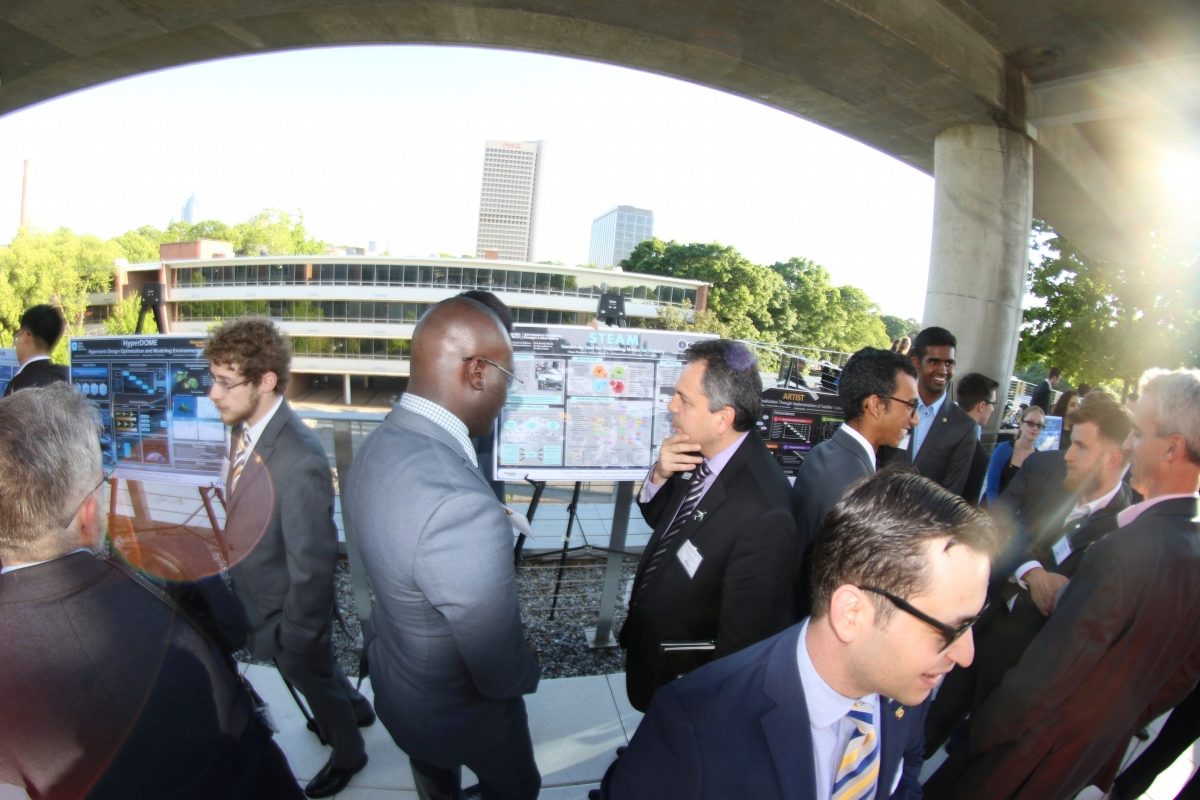
More than 85 industry and government sponsors descended on the Daniel Guggenheim School of Aerospace Engineering April 24 and 25 for an annual event that always sparks lively discussions --- and new collaborations: the External Advisory Board (EAB) meeting for the Aerospace Systems Design Lab (ASDL).
 |
| Gulfstream's Bob Martin had a great time talking with members of the DOF-SIX team during the reception that followed the team's formal presentation. |
One of the highlights of the two-day meeting was the Grand Challenge showcase, where the research sponsors were able to see the results of 25 projects that more than 60 graduate and 10 undergraduate students undertook over the the past year. Grand Challenges are open-ended, relevant, realistic research problems that require students to develop a deep understanding of a problem and the underlying theory and assumptions and to identify a practical implementation of advanced methods beyond traditional senior design problems. In depth and breadth, the Grand Challenge project is one of the most ambitious in the AE School.
Sponsors were also briefed about various student competitions, special problem projects, and master’s theses, and they learned from ASDL's research engineers about the lab's recent work across seven discipline divisions: Advanced Configurations, Advanced Methods, Civil Aviation Research, Defense & Space, Digital Engineering, Propulsion & Energy, and Transformative Aviation Concepts.
As in past years, the showcase of the Grand Challenge projects generated a lot of excitement. Participants were struck not simply by the excellence of the final presentations, but by the initiative that the ASDL teams demonstrated in completing their projects.
"During a status review a few weeks ago, I told the team that they didn't realize how much they had to do before they presented at this meeting. They had three major steps to complete, and they were on the first one," said Bob Martin, manager for Loads, Dynamics, and Mass Properties at Gulfstream Aerospace. Martin was on hand to review "Development of a Framework for Structural Investigation of eXtreme Maneuvers. (DOF-SIX)"
"I've done this for my career," Martin continued. "And I knew what could derail them with the time they had left. I knew no one person could see all of the problems that could come up. I was talking to them about what they could do if they weren't ready. But they were. They had divided up the tasks all along, and, in the final weeks, they were overseeing each other's work. Their final presentation was very polished."
 |
| Team FREEDOM met with two representatives from their sponsor, Airbus, at the EAB reception. |
Professor Dimitri Mavris was not surprised by the success of the Grand Challenge teams. The longtime director of the ASDL said that, besides being smart, the students involved in these ASDL sponsored projects are highly focused and motivated.
“Grand Challenges are part of ASDLs’ core academic and research methods training. It is very rewarding to work with the student teams and guide them in the development critical systems thinking over the course of two semesters. By the time they present to sponsors, the teams have answered the tough questions, identified the best approach, and crafted a compelling story about their challenge.”
Mavris's observations were echoed by Amanda Simpson, vice president for Research and Technology at Airbus Americas, the sponsor for the Grand Challenge named FREEDOM (Flowdown of REquirements for Engineering Design & Optimization with Manufacturing Considerations).
"These students took a tool, evaluated it, and applied it to a use case that will allow us to design and bring a product to market," she said. "The team was very polished, ready to solve complex problems that we didn't even have time to explain to them."
The ASDL External Advisory Board is comprised of chief scientists, managers, and directors of related government organizations and aerospace industry companies. The EAB's annual review is designed to give both students and research staff a chance to showcase their work. This review format has provided valuable dialogue, collaboration, technology transfers, and continued advancement.

It's all about the research. Sponsors, students, and faculty mingled and talked shop at the EAB Reception.